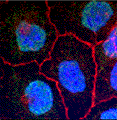Biochemistry, Department of
Document Type
Article
Date of this Version
2008
Abstract
Proteins with a conserved Cys- and His-rich SQUAMOSA promoter binding protein (SBP) domain are transcription factors restricted to photosynthetic organisms that possess a novel two Zn-finger structure DNA-binding domain. Despite the fact that altered expression of some SBP-encoding genes has profound effects on organism growth and development, little is known about SBP domain protein target genes. Misexpression of the Arabidopsis thaliana AtSPL14 SBP domain gene confers resistance to programmed cell death and modifies plant architecture. A consensus DNA-binding motif for AtSPL14 was identified by systematic evolution of ligands by exponential enrichment (SELEX) or random binding site selection (RBSS). DNA recognized by AtSPL14 contained the core binding motif (GTAC) found for other SBP domain proteins, but mutational analyses indicated that at least one additional flanking nucleotide is necessary for effective AtSPL14−DNA interaction. Comparison of several SBP domain amino acid sequences allows us to hypothesize which specific amino acids might participate in this sequence-specific DNA recognition. Electrophoretic mobility shift assays (EMSA) with mutant AtSPL14 DNA-binding domain proteins indicated that not all of the Zn2+ ion coordinating ligands in the second Zn structure are strictly required for DNA binding. Surface plasmon resonance (SPR) was used to evaluate AtSPL14 in vitro binding kinetics for comparison of equilibrium binding constants with other SBP domain proteins. These data provide a strong basis for further experiments aimed at defining and distinguishing the sets of genes regulated by the closely related SBP domain family members.
Includes Supporting Information.



Comments
Published in Biochemistry 47:12 (2008), pp 3645–3653; doi: 10.1021/bi701431y Copyright © 2008 American Chemical Society. Used by permission.